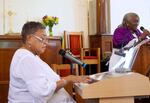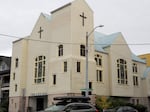Phillis Whitmore remembers when the parishioners of First African Methodist Episcopal Zion Church physically marched to its current location in 1962.
“Back then, everybody seemed to be marching,” Whitmore said. “It was kind of our symbolic thing, that we were marching from the old building into our new facility, and everybody was really into it.”
First A.M.E. Zion has no plans to move again, but its historic building could soon look drastically different, as churches across the country are grappling with how to serve an ever-shifting congregation.
First A.M.E. Zion Church — called “First Church” by its members — is the oldest Black church in Oregon, having started in a living room in 1862. It’s moved several times throughout its history but has been based in its large, ornate building on North Vancouver Avenue since the 1960s.

Parishioners at a Sunday service at First A.M.E. Zion Church in Portland, Ore. The church plans on tearing down its building and replacing it with apartments, a smaller sanctuary and other services.
Joni Land / OPB
These days, the number of people attending Sunday services at the church has slowed to a trickle, especially after the COVID-19 pandemic. As little as 10 people can be found on Sundays.
Pastor Dennis Payne, who’s been at First Church for 18 months, attributes the declining attendance to two factors: It mimics national trends other churches are seeing, and it reflects the changes in the surrounding neighborhood.
First Church’s location on North Vancouver Avenue lies in the Historic Albina neighborhood, once the heart of Portland’s Black community. Gentrification has forced out many people, with profound impacts on the area’s businesses, schools and churches.
The church has a no parking lot, which is a deterrent for worshippers forced to make a longer commute on Sundays.

Phillis Whitmore (left) plays music during Sunday services at First A.M.E. Zion Church in Portland, Ore. She has played music since she was a child and has attended this church her entire life.
Joni Land / OPB
Payne, who grew up in the area, said little remains of what the neighborhood used to be.
“When I was living here as a kid, down the street was Wonder Bread,” he said. “Every time you came to this side of the town, you would smell the bread and you would just know exactly where you are.
“We’ve had to move out of the community, because we can’t afford it.”
Churches across Oregon and the U.S. are struggling with declining memberships and the donations that follow. As a result, many are having to either sell their historic buildings or — as in the case of First A.M.E. — seriously reconsider what church will look like in future years.
It’s a conversation happening across the Pacific Northwest, a region feeling some of the greatest impacts of a nationwide housing shortage. The United Methodist Church held a conference in Portland earlier this month discussing how churches could build affordable housing units on their land.
Bishop Cedrick Bridgeforth, head of the Greater Northwest Area of The United Methodist Church, said it’s part of the church’s mission to help address one of the region’s most pressing crises.
That doesn’t mean it’s an easy process, or even a profitable one.
“The big shocker for a lot of churches is there isn’t a lot of money to be made for the church in this,” Bridgeforth said. “The church gets to do good, which is what it was designed to do from the beginning.”
He said in the future, church services will look very different than they did even a few years ago. He expects people to worship in smaller spaces, with people who share common interests.
“I think the church becomes more scattered,” Bridgeforth said. “But in that scattering can be more focused in building community and providing spiritual gathering space in smaller spaces.”
A new future for First A.M.E. Zion
The people of First A.M.E. Zion recently decided to tear down the historic building. What will replace it remains unclear, but it will be staggeringly different: multiple stories of apartments, a daycare, a smaller church sanctuary and more multi-use spaces for the community.
It will likely be an expensive project, as well. The church has partnered with Logos Faith Development, a Los Angeles-based developer that specializes in helping churches reuse their land by building affordable housing and other projects.
Logos’ managing partner, Pastor Martin Porter, said the goal is to make sure churches still have a presence in the community.
“Anytime a Black church closes, the community loses a significant treasure that sometimes you can never get back,” Porter said.
The church and Logos Faith Development are still looking for investors and others who can help finance the project, including local nonprofits, Porter said. The church would receive a portion of what revenue from the apartments on its land.
Bishop Cedrick Bridgeforth said he’s seen a sharp rise in developers working with churches on redeveloping their acreage, as more churches start this process.

The outside of First A.M.E. Zion Church in Portland, Ore. The church first moved here in 1962, but the original building is more than 100 years old and still has many historic artifacts.
Joni Land / OPB
The complex at First Church will likely take three years to complete, Payne said, and it will incorporate some of the historic artifacts found throughout the building. That includes the original chandeliers, wooden pews and stained glass windows that line the sanctuary.
The main priority for the church is to not sell the land they’ve owned for more than 60 years, Payne said.
“We want to be that entity that we’ve always had been on this corner of North Vancouver, and Skidmore, the miracle on this corner,” he said. “That’s where we want to continue to be.”
Some parishioners said it will be sad to see the old building demolished, but all expressed excitement at the new phase of First A.M.E. Zion.
Chantell Amado said some of her fondest memories are of all the children who used to attend when membership was stronger. But she’s looking forward to what the church will become, one that better serves people’s needs when it has more resources available.
“That’s the one thing about First Church — people come and go, but that feeling of family never leaves. It’s always there.”
